What Lies Ahead? Emerging Licensing Models For Commercial Content Oosterbaan
0 likes733 views
1 of 41
Downloaded 10 times
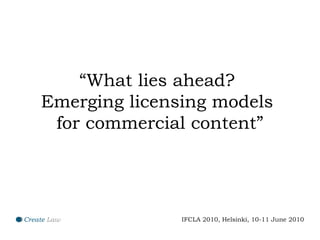


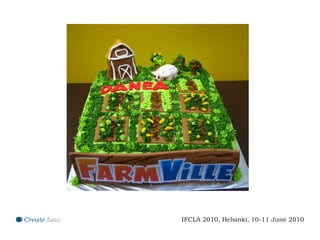
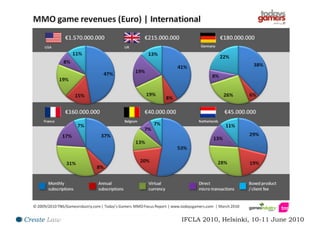


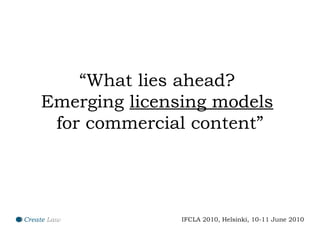
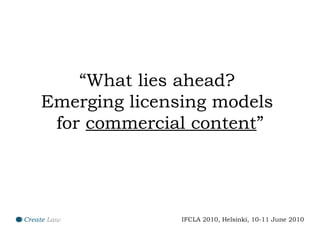



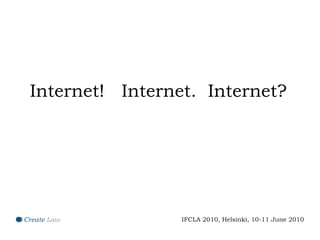
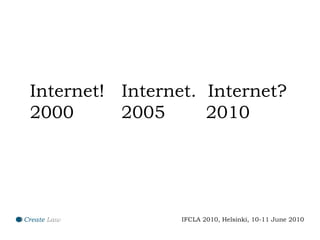
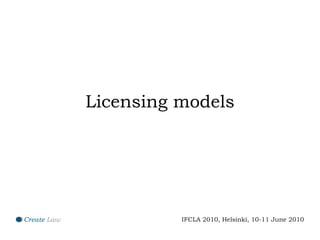
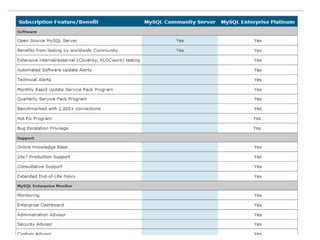
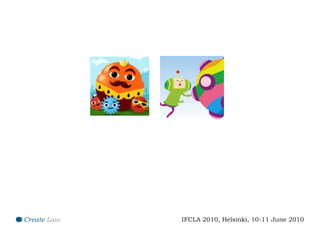
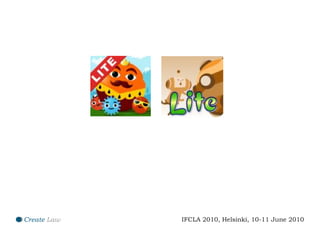


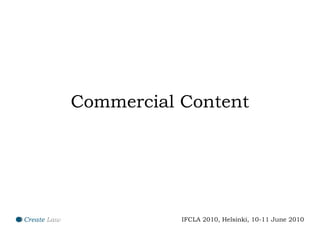


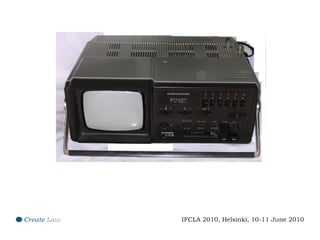




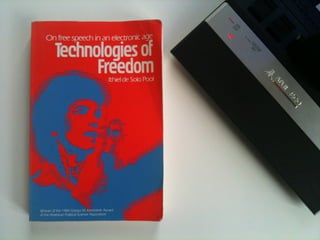
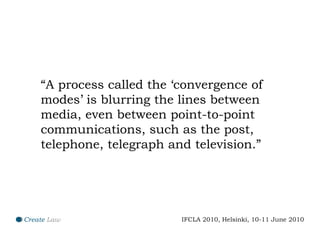




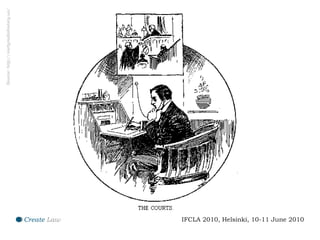

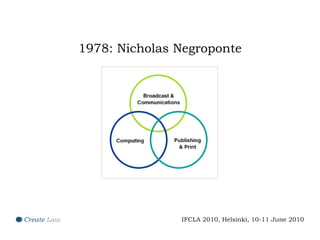

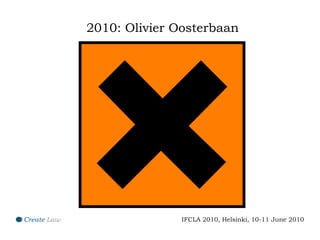

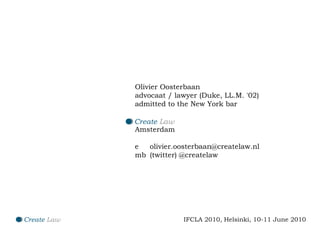
Ad
Recommended
Appel rased janvier_2011
Appel rased janvier_2011Franck Dupont
?
该文档包含了一系列数据和信息,涉及多种主题。其主要内容为对特定数据的整理与分析,可能包含统计或技术性描述。文档整体结构复杂,含有大量编码信息。Important aspects of hair transplant for men and women
Important aspects of hair transplant for men and womenSonia Singh
?
该文档包含大量文本数据,可能是编码或压缩信息。由于内容不具备可读性,因此难以提炼出具体的意义或主题。建议进一步分析或解码以获取有效信息。Short portfolio presentation by Tess Krüs
Short portfolio presentation by Tess KrüsTess Krüs
?
该文档包含大量的代码和符号,似乎是某种格式化的文本或数据结构。整体内容可能涉及信息的编码或解码,但具体含义不明确。文档缺乏可读的自然语言描述。Route 333 SE Flyer
Route 333 SE FlyerSpringboard Performance
?
此文档包含了一系列编码字符,未提供具体的主题或信息。内容显得杂乱,无法提取出有效的摘要或分析。文档中不存在可识别的语句或逻辑结构。Phone gap Stats & Growth
Phone gap Stats & GrowthAndreCharland
?
文档提供了PhoneGap的用户统计数据,包括每月超过500,000的流量和600,000次总下载。它还提到自2010年12月以来,PhoneGap Build已经拥有超过10,000个用户和23,000个应用程序。每日应用程序构建数量超过3000个,显示了该平台的活跃度和增长潜力。Caso tema 04 ca?üdiz electro?ünica
Caso tema 04 ca?üdiz electro?ünicaCarmen Hevia Medina
?
该文档包含大量不可读字符,无法提取有意义的内容或信息。可能是由于文件损坏或编码问题导致的。无法提供有效的摘要。Brazil localization jan-klass_heinsohn
Brazil localization jan-klass_heinsohnMuhammad Faisal (1200+ Members)
?
该文档包含了一系列复杂的数据和编码信息,与特定主题无关。内容可能涉及计算机编程、数据传输或类似的技术领域。总体而言,这是一篇难以解码的文本,可能不是为了直观阅读而设计的。脱炭素社会に向けたエネルギーシナリオ(中间报告?省エネルギー発表会)
脱炭素社会に向けたエネルギーシナリオ(中间报告?省エネルギー発表会)Naoyuki Yamagishi
?
文档包含了一些符号和数字,似乎缺乏连贯的内容和清晰的信息。可能需要进一步的上下文或解释来理解其含义。整体内容显得混乱,且没有提供有用的具体信息。Introduccion a-gimp
Introduccion a-gimpanahmsi
?
该文档包含大量编码字符和数据,无法提取出清晰的主题或信息。内容看似是零散的字节和符号的组合,未形成连贯的句子或段落。整体结构不符合常规文字文件的特征。Letteratura e guerra partigiana in italia
Letteratura e guerra partigiana in italiabellaciao_org
?
文档似乎包含了一些复杂的字符和符号,整体内容较为混乱,难以理解其具体主题或信息。可能涉及到技术领域的某些内容,但缺乏清晰的表达。建议对文档进行整理以提取有价值的信息。Understanding the working of refrigerator repairs in london
Understanding the working of refrigerator repairs in londonSonia Singh
?
该文档包含大量结构化数据,但呈现格式不明确。无法从中提取出清晰的信息或主题。需要更多的信息来进行有效的总结。Bici maquinas presentación
Bici maquinas presentaciónHector Dominguez
?
文档包含一系列高度结构化且复杂的信息,涉及多个主题和技术概念。通过分析可以看出,文档旨在提供对于多种交互元素和设备操作的详细描述。整体内容复杂且密集,适合对该领域有深入了解的读者。Tuille biscuits
Tuille biscuitsMerlin Cottage Kitchen
?
该文档包含多个要点和符号,但内容混乱且难以理解。主要涉及一些操作和符号结构,无法提取出明确的主题或结论。文档整体缺乏连贯性和清晰的信息。Know more about hair loss treatments
Know more about hair loss treatmentsSonia Singh
?
这篇文档包含了一系列复杂的数据和信息,但其具体内容难以识别或提取。文档可能涉及不同主题的讨论,但由于缺乏清晰的上下文与结构,理解其核心要点变得非常困难。总体来说,这是一份需要进一步整理和分析的文本。Iimm 2006
Iimm 2006Atanas Atanasov
?
文档内容涉及多方面的信息,包括数据的处理和分析、关键条款的解释和总结。具体细节尚不明确,可能与技术或项目相关。文档的格式相对复杂,包含多个数据点和结构信息。Eid e-milad-e-rasool1
Eid e-milad-e-rasool1Fahad Javed
?
文档包含了大量符号和字符,没有明显的主题或内容。信息可能是无序或随机排列的,难以提取有意义的信息。整体结构混乱,缺乏上下文和明确的意义。Easy steps to find suppliers from china
Easy steps to find suppliers from chinaSonia Singh
?
该文档包含了一系列复杂的数据和指令。信息包含程序代码或算法的元素,但没有明确的上下文。整体结构显示出深厚的技术性质。Proposal+santunan+yatim
Proposal+santunan+yatimOval Chenghoa
?
文档包含大量对于复杂主题的信息,可能是数据处理或技术相关内容。它涉及多个方面和细节,具体讨论了一些技术术语和相关概念。整体内容密集且复杂,可能需要进一步简化或解释。Overview of new UForge Migration
Overview of new UForge Migration UShareSoft
?
该文档内容复杂且难以提炼具体信息。其结构模糊,包含大量不规则的标记和乱码,无法解析出明确的主题或要点。建议对文档进行清理和重组,以便进行有效的分析和总结。Order Flagging System
Order Flagging SystemMaddy Blignaut
?
该文档包含了一系列对于订单的信息,包括供应商代码、名称、交货时间、订单状态等数据。使用了多个字段来详细描述订单的情况。整体结构呈现出处理订单的程序或表格格式。#MustRead #Flipkart #ApologyEmail
#MustRead #Flipkart #ApologyEmailRajesh Soundararajan
?
该文档包含了涉及多个方面的复杂信息,涵盖了不同主题及数据点。内容丰富且结构紧凑,适合对所述内容进行深入研究的人士。整体来说,该文档提供了综合性的视角,涉及到了详细的数据分析和论据支持。Agile project case study by a satisfied customer jora gill
Agile project case study by a satisfied customer jora gillIFCLA - International Federation of Computer Law Associations
?
Standard & Poor's is a leading provider of financial market intelligence and credit ratings. It has 11,000 employees operating across North America, Europe, Asia, India, Australia, Latin America, Africa and the Middle East. The company generates $2.6 billion in annual revenue through credit ratings, risk management services, equity research, indices, and business intelligence platforms. It aims to connect its application integration hubs in major financial centers worldwide through an agile approach that emphasizes continuous improvement.More Related Content
What's hot (19)
脱炭素社会に向けたエネルギーシナリオ(中间报告?省エネルギー発表会)
脱炭素社会に向けたエネルギーシナリオ(中间报告?省エネルギー発表会)Naoyuki Yamagishi
?
文档包含了一些符号和数字,似乎缺乏连贯的内容和清晰的信息。可能需要进一步的上下文或解释来理解其含义。整体内容显得混乱,且没有提供有用的具体信息。Introduccion a-gimp
Introduccion a-gimpanahmsi
?
该文档包含大量编码字符和数据,无法提取出清晰的主题或信息。内容看似是零散的字节和符号的组合,未形成连贯的句子或段落。整体结构不符合常规文字文件的特征。Letteratura e guerra partigiana in italia
Letteratura e guerra partigiana in italiabellaciao_org
?
文档似乎包含了一些复杂的字符和符号,整体内容较为混乱,难以理解其具体主题或信息。可能涉及到技术领域的某些内容,但缺乏清晰的表达。建议对文档进行整理以提取有价值的信息。Understanding the working of refrigerator repairs in london
Understanding the working of refrigerator repairs in londonSonia Singh
?
该文档包含大量结构化数据,但呈现格式不明确。无法从中提取出清晰的信息或主题。需要更多的信息来进行有效的总结。Bici maquinas presentación
Bici maquinas presentaciónHector Dominguez
?
文档包含一系列高度结构化且复杂的信息,涉及多个主题和技术概念。通过分析可以看出,文档旨在提供对于多种交互元素和设备操作的详细描述。整体内容复杂且密集,适合对该领域有深入了解的读者。Tuille biscuits
Tuille biscuitsMerlin Cottage Kitchen
?
该文档包含多个要点和符号,但内容混乱且难以理解。主要涉及一些操作和符号结构,无法提取出明确的主题或结论。文档整体缺乏连贯性和清晰的信息。Know more about hair loss treatments
Know more about hair loss treatmentsSonia Singh
?
这篇文档包含了一系列复杂的数据和信息,但其具体内容难以识别或提取。文档可能涉及不同主题的讨论,但由于缺乏清晰的上下文与结构,理解其核心要点变得非常困难。总体来说,这是一份需要进一步整理和分析的文本。Iimm 2006
Iimm 2006Atanas Atanasov
?
文档内容涉及多方面的信息,包括数据的处理和分析、关键条款的解释和总结。具体细节尚不明确,可能与技术或项目相关。文档的格式相对复杂,包含多个数据点和结构信息。Eid e-milad-e-rasool1
Eid e-milad-e-rasool1Fahad Javed
?
文档包含了大量符号和字符,没有明显的主题或内容。信息可能是无序或随机排列的,难以提取有意义的信息。整体结构混乱,缺乏上下文和明确的意义。Easy steps to find suppliers from china
Easy steps to find suppliers from chinaSonia Singh
?
该文档包含了一系列复杂的数据和指令。信息包含程序代码或算法的元素,但没有明确的上下文。整体结构显示出深厚的技术性质。Proposal+santunan+yatim
Proposal+santunan+yatimOval Chenghoa
?
文档包含大量对于复杂主题的信息,可能是数据处理或技术相关内容。它涉及多个方面和细节,具体讨论了一些技术术语和相关概念。整体内容密集且复杂,可能需要进一步简化或解释。Overview of new UForge Migration
Overview of new UForge Migration UShareSoft
?
该文档内容复杂且难以提炼具体信息。其结构模糊,包含大量不规则的标记和乱码,无法解析出明确的主题或要点。建议对文档进行清理和重组,以便进行有效的分析和总结。Order Flagging System
Order Flagging SystemMaddy Blignaut
?
该文档包含了一系列对于订单的信息,包括供应商代码、名称、交货时间、订单状态等数据。使用了多个字段来详细描述订单的情况。整体结构呈现出处理订单的程序或表格格式。#MustRead #Flipkart #ApologyEmail
#MustRead #Flipkart #ApologyEmailRajesh Soundararajan
?
该文档包含了涉及多个方面的复杂信息,涵盖了不同主题及数据点。内容丰富且结构紧凑,适合对所述内容进行深入研究的人士。整体来说,该文档提供了综合性的视角,涉及到了详细的数据分析和论据支持。Viewers also liked (6)
Agile project case study by a satisfied customer jora gill
Agile project case study by a satisfied customer jora gillIFCLA - International Federation of Computer Law Associations
?
Standard & Poor's is a leading provider of financial market intelligence and credit ratings. It has 11,000 employees operating across North America, Europe, Asia, India, Australia, Latin America, Africa and the Middle East. The company generates $2.6 billion in annual revenue through credit ratings, risk management services, equity research, indices, and business intelligence platforms. It aims to connect its application integration hubs in major financial centers worldwide through an agile approach that emphasizes continuous improvement.Agile project case study by a satisfied customer jora gill
Agile project case study by a satisfied customer jora gillIFCLA - International Federation of Computer Law Associations
?
Ad
Similar to What Lies Ahead? Emerging Licensing Models For Commercial Content Oosterbaan (20)
Gazeta alternativa
Gazeta alternativaMarkuns Amaral
?
该文档含有大量的信息,内容主要涉及各种数据和符号的组合,难以提炼出明确的主题或目的,整体结构复杂。文档在数字、字符与可能的编码序列中展现出多样性,但缺乏可理解的上下文。总结时注意到文档缺乏连贯性,需进一步分析以获取准确信息。Friday Sermon Dilivered by hazrat Khalifa ul Masih the 4Th (RA) 29 March 1985
Friday Sermon Dilivered by hazrat Khalifa ul Masih the 4Th (RA) 29 March 1985muzaffertahir9
?
该文档包含了大量无序数据,似乎是一些编码或加密的信息。整体内容缺乏明确的上下文,无法提取具体主题或有意义的陈述。需要进一步处理以理解其潜在含义或内容。CTBL: Beyond Curent Didactic Methods and Approaches
CTBL: Beyond Curent Didactic Methods and ApproachesSeyed Mohammad Hassan Hosseini
?
该文档包含复杂的符号和非结构化数据,难以提炼出明确的信息。文档可能涉及对数据的编码或特定格式的使用,但缺乏清晰的语义内容。需要进行进一步的处理以解码和理解其具体含义。23 leis da comunica??o espírita
23 leis da comunica??o espíritaAntonio SSantos
?
该文档包含多个信息点和段落,涉及不同的主题和内容。文档结构复杂,包含许多符号和数据,但整体主题尚不明确。整体上,该文档可能是信息或数据的集合,但具体意图需进一步分析。Friday Cermon Dilivered by Hazrat Mirza Tahir AhmedKhalifa tul Masih the 4th ...
Friday Cermon Dilivered by Hazrat Mirza Tahir AhmedKhalifa tul Masih the 4th ...muzaffertahir9
?
该文档包含大量信息,但内容不明确且无明显主题。它似乎包含一些对于数据输入或输出的技术性描述。文档的结构混乱,难以提取有意义的摘要。A Content- and Document-based Approach for Digital Productivity Applications
A Content- and Document-based Approach for Digital Productivity ApplicationsNuxeo
?
该文档包含大量未经加密的序列和符号,可能代表某种数据。要提取的信息不明显,无法 discern 它的实际内容。需要更明确的上下文或信息以进行更深入的分析。Como escribir un trabajo cientifico
Como escribir un trabajo cientificoUniversidad del Comahue- CONICET
?
该文档似乎含有大量无效字符或编码错误,无法提取出有意义的内容。文档内容未能提供相关信息或有效摘要。Caso tema 04 ca?üdiz electro?ünica
Caso tema 04 ca?üdiz electro?ünicaCarmen Hevia Medina
?
该文档包含了一系列编码和字符数据,可能是某种信息或指令的表示。内容复杂且缺乏清晰的文字描述,难以直接提取具体主题或内容。整体来看,文档可能涉及技术或程序相关的细节。Benedetti mario el-cumplea?os_de_juan_angel
Benedetti mario el-cumplea?os_de_juan_angelAndrea Domenech
?
The document appears to contain a string of characters and symbols without coherent structure or content, making it difficult to derive any meaningful summary. It does not provide clear information or key points that can be condensed into a traditional summary format.Friday Sermon Dilivered by Hazrat Mirza Tahir Ahmed Khalif tul Masih te 4th 3...
Friday Sermon Dilivered by Hazrat Mirza Tahir Ahmed Khalif tul Masih te 4th 3...muzaffertahir9
?
该文档包含一系列信息,涉及多个主题的详细数据和提示。文档结构复杂,涉及的内容包括工作流程、管理策略和技术实现。所有信息均以电子文本格式呈现,适合数据处理和分析。Friday Sermon, dilivered by Hazrat Mirza Tahir Ahmed Khalifa tul Masih the Fo...
Friday Sermon, dilivered by Hazrat Mirza Tahir Ahmed Khalifa tul Masih the Fo...muzaffertahir9
?
文档的内容看起来包括各种信息,但由于文本的乱码、重复字符和无效字节,很难明确起始和结束的主题。需要进一步清理和解析以提取可用信息。整体上,该文档似乎涉及数据结构或编码,但具体细节尚不清楚。Sesion 3 Manufactura Verde 2011
Sesion 3 Manufactura Verde 2011Hector Dominguez
?
该文档包含大量的数据和信息,可能涉及多个主题与细节。虽然具体内容未能明确解析,但可以推测其包括某种形式的数据信息或编码内容。这可能与技术、统计或者其他类型的数据处理有关。Friday Sermon Delivered by Hazrat Mirza Athir Ahmed (RA) 21 Feb 1985
Friday Sermon Delivered by Hazrat Mirza Athir Ahmed (RA) 21 Feb 1985muzaffertahir9
?
文档包含大量信息,但具体内容未明确提供。可能涉及技术、数据或算法,但无法从给定文本中提取具体的主题或要点。整体结构复杂,难以清晰解读。Friday Sermon Delivered by Hazrat Mirza Athir Ahmed (RA) 14 June 1985
Friday Sermon Delivered by Hazrat Mirza Athir Ahmed (RA) 14 June 1985muzaffertahir9
?
该文档包含大量无意义的字符和乱码,缺乏清晰的主题或信息,无法提炼出具体的摘要内容。理解此文档的原意几乎不可能,因为其结构和内容均不连贯。总体来看,文档似乎没有实际的研究或数据支持。Logiciels libres et marchés publics
Logiciels libres et marchés publicscogitis
?
该文档包含大量编码字符和不可见内容,缺乏清晰的信息或逻辑结构,因此无法提取有意义的总结。内容可能与文件格式或通信协议相关,但具体信息尚不清楚。文档未提供任何明确的主题或结论。Flash in HPC
Flash in HPCrjmurphyslideshare
?
该文档内容杂乱,包含多种符号和文本片段,缺乏清晰的结构和连贯性,难以提取具体的主题或重点信息。文档中出现了许多类似编码或加密的内容,可能需要进一步的解析或上下文来理解。总体而言,文档的可读性较差,信息传递不够明确。Neuropsychology brochure
Neuropsychology brochureDr Christopher Williams
?
该文档包含了一系列乱码和不可识别的字符,没有提供任何明确的内容或主题。文档的结构无法被解读或总结。整体来看,此文档似乎无实际可用信息。Ad
More from IFCLA - International Federation of Computer Law Associations (20)
Legal issues in the cloud renzo marchini & gene landy
Legal issues in the cloud renzo marchini & gene landyIFCLA - International Federation of Computer Law Associations
?
The document discusses several key legal issues related to cloud computing:
1) Determining who is responsible for data protection compliance as the roles of data controller and processor can be ambiguous in cloud environments.
2) Security requirements for cloud providers and whether customers can fully delegate security obligations. Certifications like ISO 27001 are discussed.
3) Cross-border data transfer issues and ensuring personal data stays within adequate jurisdictions according to the EU Data Protection Directive. Transfers to third countries require mechanisms like Safe Harbor, model contracts, or self-assessments.Agile software development how can it go wrong - purdey castle
Agile software development how can it go wrong - purdey castleIFCLA - International Federation of Computer Law Associations
?
This document discusses how agile software development can go wrong if not implemented properly. It provides an example of a project between an offshore vendor in India and a UK customer that failed due to a lack of understanding of agile methods. Key issues included using a standard development contract with fixed dates and prices instead of a flexible agreement, and limited experience with agile practices by both parties. Potential solutions involve using multi-stage, target cost or target schedule contracts; creative pricing models; and effective governance to formalize regular scope and schedule changes. The conclusion emphasizes that the contract must be dynamic to guide a collaborative relationship rather than just state obligations.Software development contractual issues susan atkinson
Software development contractual issues susan atkinsonIFCLA - International Federation of Computer Law Associations
?
This document discusses contractual issues in software development projects using agile versus waterfall methodologies. It compares the two approaches and outlines eight key features of an agile contract, including treating it as a contract for services rather than goods, using a framework agreement with time-boxed iterations, focusing on capacity over specific features, requiring customer involvement, and including metrics for productivity and quality.What is agile and how does it differ from the traditional waterfall method ...
What is agile and how does it differ from the traditional waterfall method ...IFCLA - International Federation of Computer Law Associations
?
The document discusses different approaches to software development contracts. It argues that traditional fixed-price contracts often lead to wasted effort from overly optimistic bids or excessive scope definition. Time and materials contracts put the customer at risk without proper controls. The document advocates for lean, progressive contracts that start with time and materials to establish trust, then move to fixed-price stages with continually negotiable scope beyond each stage. This allows risk to be borne appropriately and the relationship, rather than excessive controls, to limit opportunism for faster and better results.Convergence legal aspects- regulatory framework - patrick van eecke
Convergence legal aspects- regulatory framework - patrick van eeckeIFCLA - International Federation of Computer Law Associations
?
This document discusses emerging trends in information and communications technology (ICT) and their implications for the legal framework in Europe. It identifies 11 key ICT trends, such as ubiquitous computing, cloud computing, digital natives, user-generated content, and the convergence of online and offline activities. For each trend, challenges for the current European legal system are described. The document also outlines recommendations to update EU legislation to address these challenges and keep European law "future proof" in the face of rapid technological change.Whose content? whose revenue? who should be liable for a user's content? jo...
Whose content? whose revenue? who should be liable for a user's content? jo...IFCLA - International Federation of Computer Law Associations
?
The document discusses issues around user generated content on social networking sites. It addresses questions of who owns the copyright to user created content, how sites generate revenue from user content, and who should be liable for any copyright infringement by users. It provides examples from sites like Flickr, SoundCloud and Facebook. It also summarizes a report on legal issues surrounding The Pirate Bay in Sweden, including a 2009 court ruling finding them guilty of contributory copyright infringement.Service provider view how to cope with content diversity - kaisa olkkonen
Service provider view how to cope with content diversity - kaisa olkkonenIFCLA - International Federation of Computer Law Associations
?
This document discusses how Nokia manages content diversity as it transitions from a technology company to a solutions company providing media and content. It outlines challenges in managing diverse content, including differing business practices and unclear legislation between countries. It then provides examples of tools Nokia uses to manage diversity, such as balancing risk and opportunity with app distribution, developing new business models for music, and maintaining an agile and efficient legal team.Multi channel digital distribution - jp virtanen
Multi channel digital distribution - jp virtanenIFCLA - International Federation of Computer Law Associations
?
The document discusses the Finnish pay-TV market, including:
1) URHOtv entered the Finnish pay-TV market in 2010 and has partnerships with multiple cable and IPTV providers.
2) The pay-TV penetration in Finland is low at 30%, providing opportunities for growth.
3) URHOtv owns the TV rights to broadcast Finnish ice hockey league games, one of the most valuable sports properties in Finland.From isp liability to isp cooperation international developments from us dm...
From isp liability to isp cooperation international developments from us dm...IFCLA - International Federation of Computer Law Associations
?
This document discusses the evolution of ISP liability and cooperation on copyright issues. It outlines the development of safe harbors for ISPs in the DMCA and EU that protect them from liability if they meet certain conditions. New forms of infringement like P2P have challenged this framework. The document proposes a graduated response approach where ISPs send warnings to subscribers engaged in repeat infringement and can eventually suspend accounts as a deterrent. It discusses country-level laws incorporating this and debates around related issues. The conclusion is that proportionate solutions are needed that steer users to legal options without widespread litigation.Carlsberg lessons learned from re-tendering an international infrastructure ...
Carlsberg lessons learned from re-tendering an international infrastructure ...IFCLA - International Federation of Computer Law Associations
?
The document summarizes Carlsberg's process of renegotiating and partly retendering its European IT outsourcing agreement. Key points include:
- Carlsberg was not realizing the expected benefits from outsourcing and faced quality issues, triggering a renegotiation.
- The process involved benchmarking, two phases of price negotiations, expanding the scope to include acquisitions, and considering multi-sourcing.
- The new agreement extended the term, expanded scope to the Business Standardization Program, and provided more transparency and better defined pricing to the benefit of both parties. Carlsberg obtained better prices.Transfer of employees in secondary outsourcing timo karsten
Transfer of employees in secondary outsourcing timo karstenIFCLA - International Federation of Computer Law Associations
?
This document summarizes key legal considerations regarding the transfer of employees during secondary outsourcing. It discusses the Acquired Rights Directive and criteria for determining if a transfer of business has occurred, resulting in the transfer of employees and their rights. It also examines how changing an organization's structure or dividing resources between entities may avoid this. The document concludes with suggestions for contractual clauses to facilitate cooperation and information exchange between original and new service providers during a change.Managing risks when offshoring services including a practical indian experie...
Managing risks when offshoring services including a practical indian experie...IFCLA - International Federation of Computer Law Associations
?
This document summarizes a presentation on managing risks when offshoring services, including experiences from India. The key points discussed include:
- Offshoring provides benefits like lower costs, access to skilled talent, and time zone advantages, but also poses operational, strategic, and compliance risks.
- Common risks include miscommunication due to language/cultural barriers, public resistance, security/data integrity issues, and wage inflation reducing cost benefits.
- Risks can be managed through measures like joint knowledge sharing, well-defined risk matrices, transition management, and monitoring offshored activities.
- India is a favored offshore destination for its skilled English-speaking workforce and quality standards, though economic downturnExiting and replacement suppliers managing transition risk - clive davies
Exiting and replacement suppliers managing transition risk - clive daviesIFCLA - International Federation of Computer Law Associations
?
This document discusses managing the risks associated with replacing suppliers. It addresses several key themes: transitioning services smoothly from the incumbent to the new supplier; transforming services to improve them over time; properly managing the exiting supplier's departure; conducting due diligence to understand the existing environment; and carefully transferring things like subcontracts, licenses, employees, and systems. The document emphasizes that replacing a supplier requires thorough planning and coordination to minimize disruptions and ensure a successful transition.Benchmark and exit clauses how to knock down the exit barriers - ulrich b?umer
Benchmark and exit clauses how to knock down the exit barriers - ulrich b?umerIFCLA - International Federation of Computer Law Associations
?
1) The document summarizes a presentation on benchmarking and exit clauses in IT outsourcing contracts.
2) Benchmarking involves comparing performance metrics like quality, time and cost to industry best practices in order to drive continuous improvement. Exit clauses aim to manage risks when terminating outsourcing services or transitioning to a new supplier.
3) Key elements of benchmarking and exit clauses include scope, participants, process, price adjustments, personnel issues, knowledge transfer, assistance periods and dispute resolutionIt outsourcing enters new decade claudio da rold
It outsourcing enters new decade claudio da roldIFCLA - International Federation of Computer Law Associations
?
1. The presentation discusses key trends in the IT outsourcing market in 2010, including the rise of cloud computing and its impact on service providers and customers.
2. Cloud computing enables new balances of service quality, flexibility and price, while also cannibalizing traditional revenue sources.
3. This is leading providers to protect margins by investing in new offerings and delivery models, and leading customers to manage risk and take advantage of industrialized services.Navigating the privacy sea christian runte
Navigating the privacy sea christian runteIFCLA - International Federation of Computer Law Associations
?
The document discusses navigating privacy law across borders in an increasingly digital world. It notes that privacy laws have become more fragmented with advanced technology, increased data storage, and high profile data breaches. Navigating multiple jurisdictions requires understanding local laws, managing local advisors, and preparing questionnaires to ensure consistent legal advice across borders. Overall navigating privacy will only become more challenging as data and technology continue converging.Navigating the regulatory sea graham smith
Navigating the regulatory sea graham smithIFCLA - International Federation of Computer Law Associations
?
The document discusses the convergence of technologies and platforms from legal and regulatory perspectives. It notes that as telecommunications, broadcasting, IT, print media, and user-generated content continue to converge on integrated platforms, regulations have struggled to keep pace. Additionally, different content types like voice, text, images, music and video are now delivered across multiple platforms, complicating the regulatory landscape. The document concludes by advocating for a flexible, risk-based approach to navigating this changing regulatory environment.Competing while collaborating petri kuoppam?ki
Competing while collaborating petri kuoppam?kiIFCLA - International Federation of Computer Law Associations
?
This document summarizes a presentation on competing while collaborating (coopetition) through proprietary and open solutions. It discusses closed innovation versus open innovation models and the role of intellectual property in each. It also covers competition law considerations regarding proprietary and open innovation, standardization, and the new EU draft horizontal guidelines. The presentation concludes that most business models are hybrids and that standardization requires safeguards to prevent bottlenecks while enabling true interoperability through industry cooperation.Legal and ip trends in standardisation marcus glader
Legal and ip trends in standardisation marcus gladerIFCLA - International Federation of Computer Law Associations
?
This document summarizes two current EU policy developments regarding standardization: 1) The EU is modernizing its ICT standardization policy to recognize both formal and informal standard-setting organizations (SSOs) and establish criteria for recognized standards. 2) The EU is updating its competition law guidelines on cooperation in standard-setting to provide a safe harbor approach and address issues like patent disclosure and FRAND commitments to prevent hold-up problems. The document discusses ensuring openness, balance and transparency in standardization, as well as availability of standards on reasonable and non-discriminatory (RAND) or royalty-free (RF) terms.Convergence business models and services dr. klaus m. steinmaurer
Convergence business models and services dr. klaus m. steinmaurerIFCLA - International Federation of Computer Law Associations
?
This document discusses convergence in the telecommunications industry from multiple perspectives. It defines various types of convergence including fixed mobile convergence, mobile to mobile convergence, and business and private life convergence. It explains that both carriers and customers need convergence, with customers wanting seamless access across all devices. Realizing convergence presents significant technical, business and legal challenges for carriers related to IT systems, services, and regulation. The key is developing customer-centric solutions rather than focusing only on technologies.Legal issues in the cloud renzo marchini & gene landy
Legal issues in the cloud renzo marchini & gene landyIFCLA - International Federation of Computer Law Associations
?
Agile software development how can it go wrong - purdey castle
Agile software development how can it go wrong - purdey castleIFCLA - International Federation of Computer Law Associations
?
Software development contractual issues susan atkinson
Software development contractual issues susan atkinsonIFCLA - International Federation of Computer Law Associations
?
What is agile and how does it differ from the traditional waterfall method ...
What is agile and how does it differ from the traditional waterfall method ...IFCLA - International Federation of Computer Law Associations
?
Convergence legal aspects- regulatory framework - patrick van eecke
Convergence legal aspects- regulatory framework - patrick van eeckeIFCLA - International Federation of Computer Law Associations
?
Whose content? whose revenue? who should be liable for a user's content? jo...
Whose content? whose revenue? who should be liable for a user's content? jo...IFCLA - International Federation of Computer Law Associations
?
Service provider view how to cope with content diversity - kaisa olkkonen
Service provider view how to cope with content diversity - kaisa olkkonenIFCLA - International Federation of Computer Law Associations
?
Multi channel digital distribution - jp virtanen
Multi channel digital distribution - jp virtanenIFCLA - International Federation of Computer Law Associations
?
From isp liability to isp cooperation international developments from us dm...
From isp liability to isp cooperation international developments from us dm...IFCLA - International Federation of Computer Law Associations
?
Carlsberg lessons learned from re-tendering an international infrastructure ...
Carlsberg lessons learned from re-tendering an international infrastructure ...IFCLA - International Federation of Computer Law Associations
?
Transfer of employees in secondary outsourcing timo karsten
Transfer of employees in secondary outsourcing timo karstenIFCLA - International Federation of Computer Law Associations
?
Managing risks when offshoring services including a practical indian experie...
Managing risks when offshoring services including a practical indian experie...IFCLA - International Federation of Computer Law Associations
?
Exiting and replacement suppliers managing transition risk - clive davies
Exiting and replacement suppliers managing transition risk - clive daviesIFCLA - International Federation of Computer Law Associations
?
Benchmark and exit clauses how to knock down the exit barriers - ulrich b?umer
Benchmark and exit clauses how to knock down the exit barriers - ulrich b?umerIFCLA - International Federation of Computer Law Associations
?
It outsourcing enters new decade claudio da rold
It outsourcing enters new decade claudio da roldIFCLA - International Federation of Computer Law Associations
?
Navigating the privacy sea christian runte
Navigating the privacy sea christian runteIFCLA - International Federation of Computer Law Associations
?
Navigating the regulatory sea graham smith
Navigating the regulatory sea graham smithIFCLA - International Federation of Computer Law Associations
?
Competing while collaborating petri kuoppam?ki
Competing while collaborating petri kuoppam?kiIFCLA - International Federation of Computer Law Associations
?
Legal and ip trends in standardisation marcus glader
Legal and ip trends in standardisation marcus gladerIFCLA - International Federation of Computer Law Associations
?
Convergence business models and services dr. klaus m. steinmaurer
Convergence business models and services dr. klaus m. steinmaurerIFCLA - International Federation of Computer Law Associations
?
What Lies Ahead? Emerging Licensing Models For Commercial Content Oosterbaan
- 1. !#
- 2. !#
- 3. !#
- 4. !#
- 5. !#
- 6. !#
- 7. !#
- 8. !#
- 9. !#
- 10. !#
- 11. !#
- 12. !#
- 13. $ %
- 14. !#
- 15. $ %
- 16. !#
- 17. !#
- 19. !#
- 20. !#
- 21. !#
- 22. !#
- 23. !#
- 24. !#
- 25. !#
- 26. !#
- 27. !#
- 28. !#
- 29. ' !#
- 30. ' !#
- 31. !#
- 33. !#
- 34. !#
- 35. !#
- 36. !#
- 37. !#
- 38. -./01 1 ( !#
- 39. !#
- 40. 02' 2 + !#
- 41. 02' 2 + !#
- 42. 2' 2 + '3,4 56# %7%89: 1 ,; + : ' % + ,% + 5, 9 , !#
